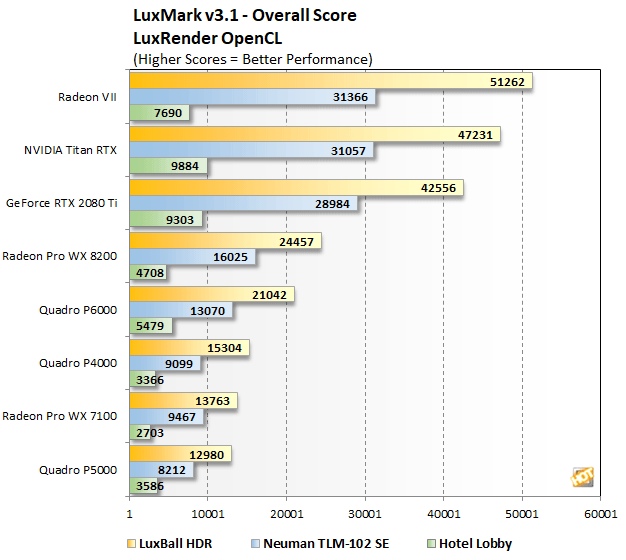LuxMark is a cross-platform,
OpenCL-accelerated 3D rendering benchmark. It's a tool based on the open source LuxRender physically-based spectral rendering engine, which accurately models the transportation of light and supports high dynamic range. LuxRender features a number of material types to allow rendering of photo-realistic and artistic scenes. LuxRender is free software, licensed under the GPL, that offers plugins for packages like Blender, Maya, Cinema 4D and 3DS Max.
 |
|
LuxMark v3.1 |
|
OpenCL Benchmark |
|
LuxMark tells an interesting story. In the LuxBall test, the
Radeon VII holds onto a respectable lead. But in the more-taxing Neuman TLM-102 SE tests the Titan RTX closes the gap considerably and then pulls head of all comers in the Hotel Lobby test.
 |
|
V-Ray Benchmark |
|
GPU Rendering Performance |
|
The V-Ray Benchmark offers both CPU and GPU rendering modes. Previous versions leveraged
NVIDIA CUDA, but the latest edition of the benchmark uses CUDA or OpenCL on GPUs and is compatible with Windows, MacOS, and Linux.
Things are tight at the top of the chart, with only a couple of seconds separating the Titan RTX from the GeForce RTX 2080 Ti here, but technically the newest Titan takes the pole position once again, with the fastest render time of the bunch in the V-Ray benchmark.
 |
|
Cinebench R15 |
|
OpenGL Benchmark |
|
Cinebench R15’s OpenGL benchmark uses a complex 3D scene depicting a car chase (created by renderbaron) to measure a GPU’s performance. The benchmark employs a large amount of geometry (nearly 1 million polygons) and textures, and features a variety of effects, such as bump maps, transparency, and complex lighting. Scores in this test are reported in frames per second...
Due to its age and modest complexity, Cinebench's OpenGL benchmarks is a relatively light-duty test that doesn't heavily tax today's high end graphics processors. The Titan RTX pulls off another first place victory nonetheless, besting the Quadro P6000 slightly and leaving the 2080 Ti in the dust. Please note, the delta versus the 2080 Ti here is not due to the Titan RTX's hardware differences, but rather NVIDIA's drivers, where the pro-graphics solutions have a clear edge in this test.









